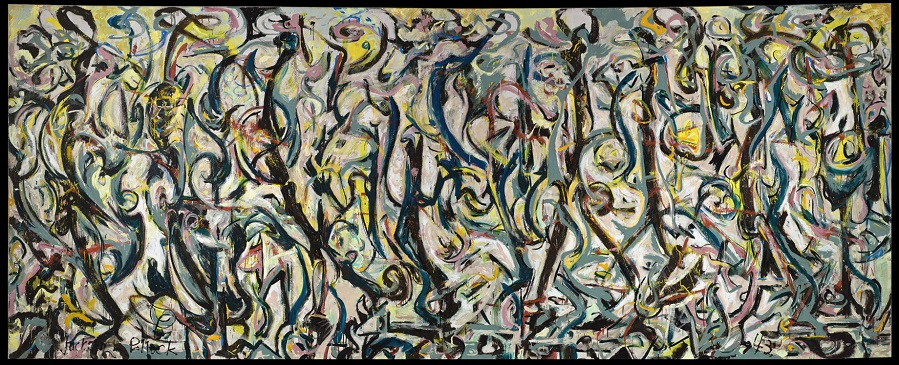Painting won’t return to Iowa City until at least 2019
Iowa City Press Citizen
Jeff Charis-Carlson , jcharisc@press-citizen.com
Published 11:40 a.m. CT June 14, 2017
After spending the past two years touring Europe, the most valuable painting in the University of Iowa’s art collection has returned to the United States and is beginning a three museum tour.
It’s been nine years since Jackson Pollock’s “Mural” has been displayed in Iowa City. The work — which has been appraised at $140 million — had to be removed in 2008 from the UI Museum of Art’s long-time home due to Iowa River flooding.
As university officials began to plan for a replacement museum building, ‘”Mural” was placed on loan with various museums throughout the state. In 2012, the painting began a two-year research and conservation process at the Getty Conservation Institute in Los Angeles.
Since then, “Mural” has been viewed by nearly 1.5 million people during stops in Los Angeles; Sioux City, Iowa; Venice, Italy; Berlin; Málaga and Bilbao, Spain; and London.
“’Mural’ has been seen by an enormous number of people, all of whom had not had the opportunity to see it before,” said Elizabeth Wallace, communications manager for the museum. “It’s a rare event. Because it is a very big painting, it doesn’t travel a lot. But when it does, it draws people like a magnet.”
Although the painting is not scheduled to come back to Iowa City until at least 2019, its first stop back in the U.S. is not too far away. From from July to October, “Mural” will be on display at the Nelson-Atkins Museum of Art in Kansas City, Mo.
The painting then will be on display from November 2017 to October 2018 at the National Gallery of Art in Washington, D.C., and from November 2018 to May 2019 at the Columbia Museum of Art in South Carolina.
UI officials recently received permission from a Iowa Board of Regents committee to move forward with designs for a new $50 million art museum building near the UI Main Library. The full board will consider the proposal during its next meeting.
The hope remains to have construction far enough along to celebrate the museum’s 50th anniversary within the new building. “Mural” is not scheduled to return to Iowa City until the new building is able to house it.
‘”Mural” is Pollock’s largest painting and art historians say it shows a transitional period in his career — pointing to the large-scale drip paintings that constitute the most famous part of his legacy.
Pollock painted “Mural” in 1943 under commission from art collector Peggy Guggenheim, who displayed the work in the entry to her Manhattan townhouse. After moving to Europe, Guggenheim agreed to give the painting to UI, and it has been part of the university’s art collection since 1951.
“It has been a win-win-win all the way around,” Wallace said of the restoration work and tours. “The art world has been able to see the painting and learn from it. The public has been able to see the painting and enjoy it. And we benefit from the painting … serving as an ambassador for the state, for the university and for our museum.”
In the first few years following the 2008 flood, there had been discussion in the Iowa Legislature about forcing the university to sell the painting to pay a portion of the university’s flood recovery efforts. UI officials argued at the time that ‘Mural’ was an Iowa treasure and that selling the collection’s most famous work would have a chilling effect on any future donations to the university.
Image caption: Jackson Pollock, Mural, 1943. Oil and casein on canvas, 95 5/8 x 237 3/4 inches. Gift of Peggy Guggenheim, 1959.6. University of Iowa Museum of Art, Iowa City. Reproduced with permission from The University of Iowa Museum of Art. Photograph courtesy the J. Paul Getty Museum, Los Angeles, 2014.
Reach Jeff Charis-Carlson at jcharisc@press-citizen.com or 319-887-5435. Follow him on Twitter: @JeffCharis.
